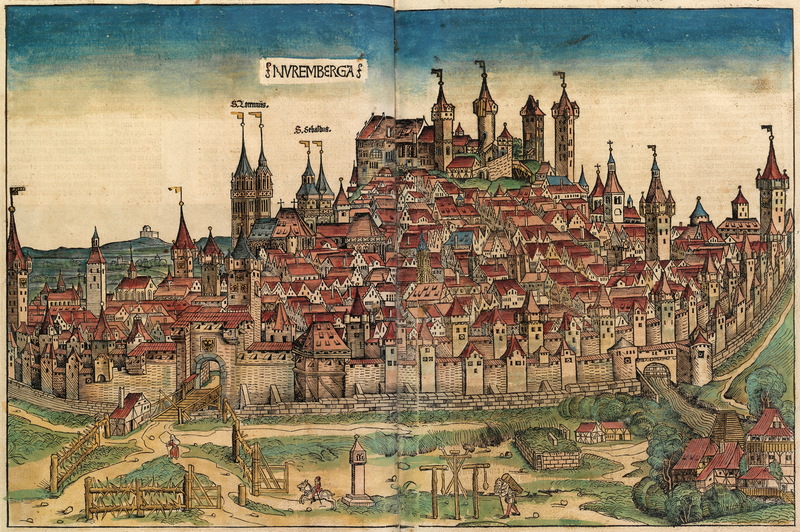Nuremberg may very well be the city where it all began for the trombone. They had the skill and technology in metalworking, the already-established brass makers, the economic means to encourage experimentation and creativity, and the cultural backdrop (for more on this, see Polk, German Instrumental Music of the Late Middle Ages). For a significant part of the trombone’s early history, the bulk of the instruments originated from makers (or distributors) in Nuremberg. During the first several decades of the trombone’s existence, German players were the most highly valued and were actually imported to play in wind bands around Europe. Many, many entries in the Trombone History Timeline involve Nuremberg, including two entries in my last blog post. Today I added seven more timeline entries (two of which are old ones that I’ve expanded):
1421—Nuremberg, Germany: Accounts indicate that musicians of the court of Margrave of Brandenburg include a 4-part shawm band with trombones (posaunen). The musicians in the account are referred to separately: first, 2 trumpets (“2g…trummetern”), then a 4-part shawm band with trombone (“4 g. markgraf Fridrichs pusaunern und pfeiffern”). Thus, according to historian Keith Polk, “This document carries particular authority with its reference to both ‘trummeten’ and ‘posaunen'” (Polk, German 66).
1458—Nuremberg, Germany: The Duke of Saxony visits Nuremberg, bringing with him the following musicians: “4 trummeters, 3 pfeiffer und 2 posaunen.” Historian Keith Polk points out that these musicians likely comprise two different ensembles: “one a band of four natural trumpets, the other a shawm band consisting of three shawms and two trombones” (Polk, German 59).
1503—Nuremberg, Germany: Trombones are among the instruments likely performing for an annual carnival celebration (Schembartlauf). An account of the festivities reads, “There were also present all types of trombones [Posaunen], drums and other sounds, just as when a king, prince, or great potentate arrived on horseback.” (Historian Helen Green points out that, by posaunen, it is “indeterminable whether trumpets or trombones are intended here”) (Green, Defining).
1518—Nuremberg, Germany: The Stadtpfeifer, including trombonist Hans Neuschel, are allowed the special honor of standing, as part of the Schembartlauf carnival, upon the grand pageant wagon that is drawn through the streets to mark the end of the city’s carnival (Green, Defining).
1541—Nuremberg, Germany and Königsberg, Prussia (now Kaliningrad, Russia): In an interesting exchange with prominent brass instrument maker George Neuschel of Nuremberg, Duke Albrecht orders, among other supplies, “4 tenor trombone mouthpieces” and “1 crook of a fourth for the quart-trombone.” Neuschel, in turn, attempts to sell Duke Albrecht numerous additional instruments and parts, including “1 silver trombone with a crook of a fourth, for use with voices and instruments” and “5 trombones, which are tuned together and from which a tenor trombone may be made into a bass or an alto” (Downey, From the Rim 8). This exchange highlights several items of historical importance, including the early use of crooks on trombones, specific mention of the trombone’s “use with voices and instruments,” reference to different ranges and sizes of trombones, the making of silver trombones, and the use of trombones by Duke Albrecht.
1581—Nuremberg, Germany: The earliest mouthpiece “that survives apparently with the instrument for which it was made” is a tenor trombone mouthpiece by Anton Schnitzer the Elder. It bears the same mark as an accompanying instrument by Schnitzer, which contains the date 1581 on the bell garland (Palais Lascaris, Nice). In general, based on extant examples, illustrations, and treatises, early mouthpieces have flat rims, shallow cups, and narrow apertures (Herbert, Sackbut 73; Herbert, Trombone 16).
1587—Nuremberg, Germany: An inventory of the Nuremberg Frauenkirche notes, “Further, a short double-trombone [kursze Toppel Posaunen] was returned in 1587 to Anton Schnitzer, to whom it belongs. One piece” (Raquet).

John Leite
No reference to Serpent Horns here. How do you ignore them?
wkimball
No reference to serpents? That’s because the post is about trombones. Here’s a link to a post with many, many serpents: https://kimballtrombone.com/2010/07/15/ophicleide-history-and-images/